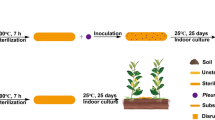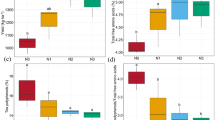Abstract
Background and aim
Pea-tea intercropping is known to improve tea quality but its potential mechanism remains unclear. This study aimed to elucidate the effects of pea-tea intercropping on rhizosphere soil microbial communities and interpret its potential role in the improvement of tea quality.
Methods
A high-throughput sequencing method was used to detect the microbial communities in the rhizosphere of pea-intercropped tea plants. KEGG and eggNOG databases were used for the functional annotation of microbial DNA sequences. Carbohydrate-active enzymes were used to evaluate soil quality.
Results
Some microbes in the rhizosphere of pea-intercropped tea plants showed large variations, particularly phyla Acidobacteria and Proteobacteria. The abundance of Bradyrhizobiaceae of Proteobacteria, which help in nitrogen fixation, increased significantly. The annotation of carbohydrate-active enzymes revealed that the relative content of glycoside hydrolases (GHs) increased significantly in the soil microbes of pea-intercropped tea plants. The KEGG analysis showed that more amino acid- and carbohydrate metabolism-related genes were enriched in the soil microbes of pea-intercropped tea plants. To sum up, pea-tea intercropping could improve tea quality by regulating soil microbes in terms of carbon- and nitrogen-fixing capacities.






Similar content being viewed by others

Data availability
The raw data was submitted to the NCBI database under accession number PRJNA939981.
References
Cantarel BL, Coutinho PM, Rancurel C, Bernard T, Lombard V, Henrissat B (2009) The carbohydrate-active EnZymes database (CAZy): an expert resource for Glycogenomics. Nucleic Acids Res 37:D233–D238. https://doi.org/10.1093/nar/gkn663
Chen S, Zhou Y, Chen Y, Gu J (2018) Fastp: an ultra-fast all-in-one FASTQ preprocessor. Bioinformatics 34:i884–i890. https://doi.org/10.1093/bioinformatics/bty560
Costenoble R, Picotti P, Reiter L, Stallmach R, Heinemann M, Sauer U, Aebersold R (2011) Comprehensive quantitative analysis of central carbon and amino-acid metabolism in Saccharomyces cerevisiae under multiple conditions by targeted proteomics. Mol Syst Biol 7:464. https://doi.org/10.1038/msb.2010.122
Dong P, Wang H, Fang T, Wang Y, Ye Q (2019) Assessment of extracellular antibiotic resistance genes (eARGs) in typical environmental samples and the transforming ability of eARG. Environ Int 125:90–96. https://doi.org/10.1016/j.envint.2019.01.050
Duan Y, Shen J, Zhang X, Wen B, Ma Y, Wang Y, Fang W, Zhu X (2019) Effects of soybean–tea intercropping on soil-available nutrients and tea quality. Acta Physiol Plant 41. https://doi.org/10.1007/s11738-019-2932-8
Duan Y, Shang X, Liu G, Zou Z, Zhu X, Ma Y, Li F, Fang W (2021) The effects of tea plants-soybean intercropping on the secondary metabolites of tea plants by metabolomics analysis. BMC Plant Biol 21:482. https://doi.org/10.1186/s12870-021-03258-1
Esiobu N, Hoosein NJAVL (2003) An assessment of the in vitro antimicrobial effects of two antiepileptic drugs – sodium valproate and phenytoin. Antonie Van Leeuwenhoek 83:63–68. https://doi.org/10.1023/A:1022992224594
Figueroa CM, Feil R, Ishihara H, Watanabe M, Kolling K, Krause U, Hohne M, Encke B, Plaxton WC, Zeeman SC, Li Z, Schulze WX, Hoefgen R, Stitt M, Lunn JE (2016) Trehalose 6-phosphate coordinates organic and amino acid metabolism with carbon availability. Plant J 85:410–423. https://doi.org/10.1111/tpj.13114
Gurevich A, Saveliev V, Vyahhi N, Tesler G (2013) QUAST: quality assessment tool for genome assemblies. Bioinformatics 29:1072–1075. https://doi.org/10.1093/bioinformatics/btt086
Huang Z, Cui C, Cao Y, Dai J, Cheng X, Hua S, Wang W, Duan Y, Petropoulos E, Wang H, Zhou L, Fang W, Zhong Z (2022) Tea plant-legume intercropping simultaneously improves soil fertility and tea quality by changing bacillus species composition. Hortic Res. https://doi.org/10.1093/hr/uhac046
Jacoby R, Peukert M, Succurro A, Koprivova A, Kopriva S (2017) The role of soil microorganisms in plant mineral nutrition—current knowledge and future directions 8. https://doi.org/10.3389/fpls.2017.01617
Jia B, Raphenya AR, Alcock B, Waglechner N, Guo P, Tsang KK, Lago BA, Dave BM, Pereira S, Sharma AN, Doshi S, Courtot M, Lo R, Williams LE, Frye JG, Elsayegh T, Sardar D, Westman EL, Pawlowski AC et al (2017) CARD 2017: expansion and model-centric curation of the comprehensive antibiotic resistance database. Nucleic Acids Res 45:D566–D573. https://doi.org/10.1093/nar/gkw1004
Kalam S, Basu A, Ahmad I, Sayyed RZ, El-Enshasy HA, Dailin DJ, Suriani NL (2020) Recent understanding of soil acidobacteria and their ecological significance: a critical review. 11. https://doi.org/10.3389/fmicb.2020.580024
Kanehisa M, Goto S, Kawashima S, Okuno Y, Hattori M (2004) The KEGG resource for deciphering the genome. Nucleic Acids Res 32:D277–D280. https://doi.org/10.1093/nar/gkh063
Li D, Liu CM, Luo R, Sadakane K, Lam TW (2015) MEGAHIT: an ultra-fast single-node solution for large and complex metagenomics assembly via succinct de Bruijn graph. Bioinformatics 31:1674–1676. https://doi.org/10.1093/bioinformatics/btv033
Li Y, Pan F, Yao H (2018) Response of symbiotic and asymbiotic nitrogen-fixing microorganisms to nitrogen fertilizer application. J Soils Sediments 19:1948–1958. https://doi.org/10.1007/s11368-018-2192-z
Ma Y-h, S-l F, X-p Z, Zhao K, Chen HYH (2017) Intercropping improves soil nutrient availability, soil enzyme activity and tea quantity and quality. Appl Soil Ecol 119:171–178. https://doi.org/10.1016/j.apsoil.2017.06.028
Ma Q, Song L, Niu Z, Qiu Z, Sun H, Ren Z, Wu H, Wang Y, Mei H, Li X, Ding Z (2022) Pea-tea intercropping improves tea quality through regulating amino acid metabolism and flavonoid biosynthesis. Foods 11. https://doi.org/10.3390/foods11223746
Maclean RC, Millan ASJS (2019) The evolution of antibiotic resistance. Science 365:1082–1083. https://doi.org/10.1126/science.aax3879
Powell S, Forslund K, Szklarczyk D, Trachana K, Roth A, Huerta-Cepas J, Gabaldon T, Rattei T, Creevey C, Kuhn M, Jensen LJ, von Mering C, Bork P (2014) eggNOG v4.0: nested orthology inference across 3686 organisms. Nucleic Acids Res 42:D231–D239. https://doi.org/10.1093/nar/gkt1253
Rahav E, Giannetto MJ, Bar-Zeev EJR (2016) Contribution of mono and polysaccharides to heterotrophic N2 fixation at the eastern Mediterranean coastline. Sci Rep 6:27858. https://doi.org/10.1038/srep27858
Rossi MF, Mello B, Schrago CG (2017) Performance of hidden Markov models in recovering the standard classification of glycoside hydrolases. Evol Bioinformatics Online 13:1176934317703401. https://doi.org/10.1177/1176934317703401
Schandry N, Becker C (2020) Allelopathic plants: models for studying plant-Interkingdom interactions. Trends Plant Sci 25:176–185. https://doi.org/10.1016/j.tplants.2019.11.004
Souza RC, Hungria M, Cantão ME, Vasconcelos ATR, Nogueira MA, Vicente VA (2015) Metagenomic analysis reveals microbial functional redundancies and specificities in a soil under different tillage and crop-management regimes. Appl Soil Ecol 86:106–112. https://doi.org/10.1016/j.apsoil.2014.10.010
Steinegger M, Soding J (2017) MMseqs2 enables sensitive protein sequence searching for the analysis of massive data sets. Nat Biotechnol 35:1026–1028. https://doi.org/10.1038/nbt.3988
Wang C, Liu D, Bai E (2018) Decreasing soil microbial diversity is associated with decreasing microbial biomass under nitrogen addition. Soil Biol Biochem 120:126–133. https://doi.org/10.1016/j.soilbio.2018.02.003
Wang Y, Liu L, Yang J, Duan Y, Luo Y, Taherzadeh MJ, Li Y, Li H, Awasthi MK, Zhao Z (2020) The diversity of microbial community and function varied in response to different agricultural residues composting. Sci Total Environ 715:136983. https://doi.org/10.1016/j.scitotenv.2020.136983
Wu T, Qin Y, Li M (2021) Intercropping of tea (Camellia sinensis L.) and Chinese chestnut: variation in the structure of rhizosphere bacterial communities. J Soil Sci Plant Nutr 21:2178–2190. https://doi.org/10.1007/s42729-021-00513-0
Xu A, Li L, Coulter JA, Xie J, Gopalakrishnan S, Zhang R, Luo Z, Cai L, Liu C, Wang L, Khan S (2020) Long-term nitrogen fertilization impacts on soil Bacteria, grain yield and nitrogen use efficiency of wheat in semiarid loess plateau. China. 10:1175
Yan P, Shen C, Fan L, Li X, Zhang L, Zhang L, Han W (2018) Tea planting affects soil acidification and nitrogen and phosphorus distribution in soil. Agric Ecosyst Environ 254:20–25. https://doi.org/10.1016/j.agee.2017.11.015
Zhao C, Ni H, Zhao L, Zhou L, Borrás-Hidalgo O, Cui R (2020) High nitrogen concentration alter microbial community in Allium fistulosum rhizosphere. PLoS One 15:e0241371. https://doi.org/10.1371/journal.pone.0241371
Zhu W, Lomsadze A, Borodovsky M (2010) Ab initio gene identification in metagenomic sequences. Nucleic Acids Res 38:e132. https://doi.org/10.1093/nar/gkq275
Acknowledgments
This study was supported by Natural Science Fund of Shandong Province (ZR2021QC159), Shandong Agricultural Seed Engineering Project (2020LZGC010), The Open Project of Liaocheng Universtiy Landscape Architecture Discipline (319462212) and Changqing Tea Team Fund. We thank TopEdit (www.topeditsci.com) for its linguistic assistance during the preparation of this manuscript.
Author information
Authors and Affiliations
Contributions
Conceptualization, Q.M., X.H., and Z.D.; methodology, L.S. and Z.N.; software, Z.Q.; validation, S. Z., and S.C.; resources, Y.W.; data curation, L.S.; writing—original draft preparation, L.S.; writing—review and editing, Z.D. and Q.M.; visualization, Q.M.; supervision, Z.D. and X.H.; funding acquisition, Q.M., Z.D. and S.C. All authors have read and agreed to the published version of the manuscript.
Corresponding authors
Ethics declarations
Conflict of interest
The authors declare that they have no conflict of interest.
Additional information
Responsible Editor: Hans Lambers.
Publisher’s Note
Springer Nature remains neutral with regard to jurisdictional claims in published maps and institutional affiliations.
Rights and permissions
Springer Nature or its licensor (e.g. a society or other partner) holds exclusive rights to this article under a publishing agreement with the author(s) or other rightsholder(s); author self-archiving of the accepted manuscript version of this article is solely governed by the terms of such publishing agreement and applicable law.
About this article
Cite this article
Laichao, S., Zhanhai, N., Shiliang, C. et al. Effects of pea-tea intercropping on rhizosphere soil microbial communities. Plant Soil (2023). https://doi.org/10.1007/s11104-023-06321-y
Received:
Accepted:
Published:
DOI: https://doi.org/10.1007/s11104-023-06321-y



